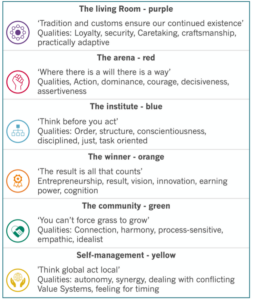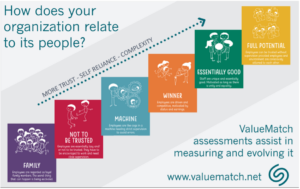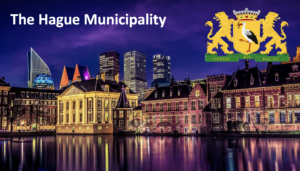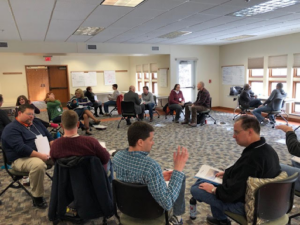A video in which Netflix CEO Reed Hastings states that a company is not a family but more like a pro-sports team, recently went viral. Hastings is brutally honest about his company’s focus, yet is this true for other organizations?
I had a friend who worked at a family-owned trucking company, happily enjoying the life of a truck driver when in his late twenties disaster hit and an illness left him half-paralyzed. The company supported him through his illness and when it was clear he could no longer drive trucks, they helped him re-educate himself and provided him with a job in the office. Their loyalty was rewarded, and he ended up working there for another 30 years. This is not the culture that Hastings describes. While the trucking company and Netflix are undoubtedly operating in very different markets, and the trucking company has not brought the financial gain that Netflix enjoys, both are successful companies in their way, and both provide a role in our society and a living for many people.
 There is much written and said by successful businesspeople, coaches, and academics about what brings success. What most fail to address is that these formulas for success work in a certain context, but not in others. The culture of companies, their market, their opportunities, their challenges, and other external and internal factors differ greatly. While there are certainly best practices and successful CEOs like Hastings do have their experience to share, we have to put what they say into the perspective of the specific culture they have built.
There is much written and said by successful businesspeople, coaches, and academics about what brings success. What most fail to address is that these formulas for success work in a certain context, but not in others. The culture of companies, their market, their opportunities, their challenges, and other external and internal factors differ greatly. While there are certainly best practices and successful CEOs like Hastings do have their experience to share, we have to put what they say into the perspective of the specific culture they have built.
 Although reality can never really be fully captured in models, adult development theories, and specifically the work of Graves, Beck, and Cowan known under the name of Spiral Dynamics, can offer us a lot of insights into organizational culture and how it can vary. This model describes various developmental layers in our society, and each layer details both the internal aspects, inner values or worldviews, and external aspects, the life conditions or environment the layer builds. The model can also be used to analyze organizational culture.
Hastings gives a perfect description of what Spiral Dynamics calls the orange values system, in which people primarily focus on success, expressed in trying to make a career and financial gain, but also in demonstrating that they are the best in what they do. Many corporations these days will strive for such a culture, especially public companies whose primary focus is to increase stockholder values. The comparison with a professional sports team is great, while what they do, their business, will be very different, the underlying values and worldview that drive them are very similar, both strive to be the best. Hastings is right, in a pure orange culture profit is the bottom line, which gives little space for treating your employees consistently as family.
My friend’s employer demonstrated something different, he did see his employees as an extension of his family and was prepared to sacrifice his bottom line to demonstrate loyalty. This points to the Spiral Dynamics purple worldview, in which the focus is to create a loyal and safe environment in which kinship and security are key. For them, long-term continuity and making sure their family can take over the business are more important than short-term growth.
In today’s world, we see six different cultural systems in organizations, see the image. For instance, old-style government organizations often demonstrate blue values, focusing on structure, and continuity within a strict hierarchical framework. These organizations are more task-driven than result-driven and are good at providing a reliable service that does not require too much adaption to a market, such as a tax office. These days we also see green values emerge more in organizations, where the focus shifts from profit to providing a harmonious work environment often more socially focused. In my consulting practice, I worked several times with social workers who thrive well in such a culture.
As I wrote, models are great, yet real life is often more complex. Most organizations express a combination of values, not simply one system. Many of today’s corporations while driven by strong orange success values are currently developing more green values in their culture, where the focus on profit is supported by a culture that seeks to provide a human-friendly harmonious culture. Start-ups may see a combination of purple family values; a group of friends who started it, while driven by strong orange, green, or yellow values. Yes, also in today’s corporations, we do find that some see their employees more as family than others, although often to a limited extent.
There is a progression. Over time, as our society develops the systems become more complex, simply to deal with more complex problems. But that does not mean that more complex is always better. What fits best depends on the social environment or life conditions we face. A financial service company in London deals with a more complex environment than a local bakery, but that does not make one better than the other.
Although reality can never really be fully captured in models, adult development theories, and specifically the work of Graves, Beck, and Cowan known under the name of Spiral Dynamics, can offer us a lot of insights into organizational culture and how it can vary. This model describes various developmental layers in our society, and each layer details both the internal aspects, inner values or worldviews, and external aspects, the life conditions or environment the layer builds. The model can also be used to analyze organizational culture.
Hastings gives a perfect description of what Spiral Dynamics calls the orange values system, in which people primarily focus on success, expressed in trying to make a career and financial gain, but also in demonstrating that they are the best in what they do. Many corporations these days will strive for such a culture, especially public companies whose primary focus is to increase stockholder values. The comparison with a professional sports team is great, while what they do, their business, will be very different, the underlying values and worldview that drive them are very similar, both strive to be the best. Hastings is right, in a pure orange culture profit is the bottom line, which gives little space for treating your employees consistently as family.
My friend’s employer demonstrated something different, he did see his employees as an extension of his family and was prepared to sacrifice his bottom line to demonstrate loyalty. This points to the Spiral Dynamics purple worldview, in which the focus is to create a loyal and safe environment in which kinship and security are key. For them, long-term continuity and making sure their family can take over the business are more important than short-term growth.
In today’s world, we see six different cultural systems in organizations, see the image. For instance, old-style government organizations often demonstrate blue values, focusing on structure, and continuity within a strict hierarchical framework. These organizations are more task-driven than result-driven and are good at providing a reliable service that does not require too much adaption to a market, such as a tax office. These days we also see green values emerge more in organizations, where the focus shifts from profit to providing a harmonious work environment often more socially focused. In my consulting practice, I worked several times with social workers who thrive well in such a culture.
As I wrote, models are great, yet real life is often more complex. Most organizations express a combination of values, not simply one system. Many of today’s corporations while driven by strong orange success values are currently developing more green values in their culture, where the focus on profit is supported by a culture that seeks to provide a human-friendly harmonious culture. Start-ups may see a combination of purple family values; a group of friends who started it, while driven by strong orange, green, or yellow values. Yes, also in today’s corporations, we do find that some see their employees more as family than others, although often to a limited extent.
There is a progression. Over time, as our society develops the systems become more complex, simply to deal with more complex problems. But that does not mean that more complex is always better. What fits best depends on the social environment or life conditions we face. A financial service company in London deals with a more complex environment than a local bakery, but that does not make one better than the other.
 Understanding the values that your organization’s culture expresses, is important for several reasons. First, it will help you to communicate clearly, like Hastings, who does not try to create a delusion of a family company. His employees know what he stands for, what to expect, and what not.
Then it will help you navigate your market, especially under changing conditions. You may open an office in a different country or region that expresses different values. The Dutch working in Germany for instance, need to learn about stronger blue values in German society and organizations. Working for Microsoft in the 90’s I did consulting work in various parts of the world, I learned to adapt to the more purple/blue culture of Malaysia in which personal relationships and ethnic background are a lot more important than in the US orange-dominated business world.
Internally in our organizations, consistency, and clarity about who we are and why we do what we do is equally important. Professionals working with Spiral Dynamics have solved many conflicts in organizations that had their bases in different worldviews and values. Mergers require a thorough investigation of what cultures need to work together now and clarity on what direction to choose. Under many organizational change projects, there is a wish to get rid of old values and worldviews and introduce new ones, and at the same time, we need to be careful not to demand too much change or to try to use methods that don’t fit our culture. Agile for instance is a method that requires some yellow in the culture to deal with its complexity and some green is required for a different type of teamwork. Without these values present in the culture, many Agile implementations are less successful than anticipated.
ValueMatch offers trainings that makes you understand and apply Spiral Dynamics and provides assessment instruments that measure values in people and organizational culture.
Understanding the values that your organization’s culture expresses, is important for several reasons. First, it will help you to communicate clearly, like Hastings, who does not try to create a delusion of a family company. His employees know what he stands for, what to expect, and what not.
Then it will help you navigate your market, especially under changing conditions. You may open an office in a different country or region that expresses different values. The Dutch working in Germany for instance, need to learn about stronger blue values in German society and organizations. Working for Microsoft in the 90’s I did consulting work in various parts of the world, I learned to adapt to the more purple/blue culture of Malaysia in which personal relationships and ethnic background are a lot more important than in the US orange-dominated business world.
Internally in our organizations, consistency, and clarity about who we are and why we do what we do is equally important. Professionals working with Spiral Dynamics have solved many conflicts in organizations that had their bases in different worldviews and values. Mergers require a thorough investigation of what cultures need to work together now and clarity on what direction to choose. Under many organizational change projects, there is a wish to get rid of old values and worldviews and introduce new ones, and at the same time, we need to be careful not to demand too much change or to try to use methods that don’t fit our culture. Agile for instance is a method that requires some yellow in the culture to deal with its complexity and some green is required for a different type of teamwork. Without these values present in the culture, many Agile implementations are less successful than anticipated.
ValueMatch offers trainings that makes you understand and apply Spiral Dynamics and provides assessment instruments that measure values in people and organizational culture.
 There is much written and said by successful businesspeople, coaches, and academics about what brings success. What most fail to address is that these formulas for success work in a certain context, but not in others. The culture of companies, their market, their opportunities, their challenges, and other external and internal factors differ greatly. While there are certainly best practices and successful CEOs like Hastings do have their experience to share, we have to put what they say into the perspective of the specific culture they have built.
There is much written and said by successful businesspeople, coaches, and academics about what brings success. What most fail to address is that these formulas for success work in a certain context, but not in others. The culture of companies, their market, their opportunities, their challenges, and other external and internal factors differ greatly. While there are certainly best practices and successful CEOs like Hastings do have their experience to share, we have to put what they say into the perspective of the specific culture they have built.
 Although reality can never really be fully captured in models, adult development theories, and specifically the work of Graves, Beck, and Cowan known under the name of Spiral Dynamics, can offer us a lot of insights into organizational culture and how it can vary. This model describes various developmental layers in our society, and each layer details both the internal aspects, inner values or worldviews, and external aspects, the life conditions or environment the layer builds. The model can also be used to analyze organizational culture.
Hastings gives a perfect description of what Spiral Dynamics calls the orange values system, in which people primarily focus on success, expressed in trying to make a career and financial gain, but also in demonstrating that they are the best in what they do. Many corporations these days will strive for such a culture, especially public companies whose primary focus is to increase stockholder values. The comparison with a professional sports team is great, while what they do, their business, will be very different, the underlying values and worldview that drive them are very similar, both strive to be the best. Hastings is right, in a pure orange culture profit is the bottom line, which gives little space for treating your employees consistently as family.
My friend’s employer demonstrated something different, he did see his employees as an extension of his family and was prepared to sacrifice his bottom line to demonstrate loyalty. This points to the Spiral Dynamics purple worldview, in which the focus is to create a loyal and safe environment in which kinship and security are key. For them, long-term continuity and making sure their family can take over the business are more important than short-term growth.
In today’s world, we see six different cultural systems in organizations, see the image. For instance, old-style government organizations often demonstrate blue values, focusing on structure, and continuity within a strict hierarchical framework. These organizations are more task-driven than result-driven and are good at providing a reliable service that does not require too much adaption to a market, such as a tax office. These days we also see green values emerge more in organizations, where the focus shifts from profit to providing a harmonious work environment often more socially focused. In my consulting practice, I worked several times with social workers who thrive well in such a culture.
As I wrote, models are great, yet real life is often more complex. Most organizations express a combination of values, not simply one system. Many of today’s corporations while driven by strong orange success values are currently developing more green values in their culture, where the focus on profit is supported by a culture that seeks to provide a human-friendly harmonious culture. Start-ups may see a combination of purple family values; a group of friends who started it, while driven by strong orange, green, or yellow values. Yes, also in today’s corporations, we do find that some see their employees more as family than others, although often to a limited extent.
There is a progression. Over time, as our society develops the systems become more complex, simply to deal with more complex problems. But that does not mean that more complex is always better. What fits best depends on the social environment or life conditions we face. A financial service company in London deals with a more complex environment than a local bakery, but that does not make one better than the other.
Although reality can never really be fully captured in models, adult development theories, and specifically the work of Graves, Beck, and Cowan known under the name of Spiral Dynamics, can offer us a lot of insights into organizational culture and how it can vary. This model describes various developmental layers in our society, and each layer details both the internal aspects, inner values or worldviews, and external aspects, the life conditions or environment the layer builds. The model can also be used to analyze organizational culture.
Hastings gives a perfect description of what Spiral Dynamics calls the orange values system, in which people primarily focus on success, expressed in trying to make a career and financial gain, but also in demonstrating that they are the best in what they do. Many corporations these days will strive for such a culture, especially public companies whose primary focus is to increase stockholder values. The comparison with a professional sports team is great, while what they do, their business, will be very different, the underlying values and worldview that drive them are very similar, both strive to be the best. Hastings is right, in a pure orange culture profit is the bottom line, which gives little space for treating your employees consistently as family.
My friend’s employer demonstrated something different, he did see his employees as an extension of his family and was prepared to sacrifice his bottom line to demonstrate loyalty. This points to the Spiral Dynamics purple worldview, in which the focus is to create a loyal and safe environment in which kinship and security are key. For them, long-term continuity and making sure their family can take over the business are more important than short-term growth.
In today’s world, we see six different cultural systems in organizations, see the image. For instance, old-style government organizations often demonstrate blue values, focusing on structure, and continuity within a strict hierarchical framework. These organizations are more task-driven than result-driven and are good at providing a reliable service that does not require too much adaption to a market, such as a tax office. These days we also see green values emerge more in organizations, where the focus shifts from profit to providing a harmonious work environment often more socially focused. In my consulting practice, I worked several times with social workers who thrive well in such a culture.
As I wrote, models are great, yet real life is often more complex. Most organizations express a combination of values, not simply one system. Many of today’s corporations while driven by strong orange success values are currently developing more green values in their culture, where the focus on profit is supported by a culture that seeks to provide a human-friendly harmonious culture. Start-ups may see a combination of purple family values; a group of friends who started it, while driven by strong orange, green, or yellow values. Yes, also in today’s corporations, we do find that some see their employees more as family than others, although often to a limited extent.
There is a progression. Over time, as our society develops the systems become more complex, simply to deal with more complex problems. But that does not mean that more complex is always better. What fits best depends on the social environment or life conditions we face. A financial service company in London deals with a more complex environment than a local bakery, but that does not make one better than the other.
 Understanding the values that your organization’s culture expresses, is important for several reasons. First, it will help you to communicate clearly, like Hastings, who does not try to create a delusion of a family company. His employees know what he stands for, what to expect, and what not.
Then it will help you navigate your market, especially under changing conditions. You may open an office in a different country or region that expresses different values. The Dutch working in Germany for instance, need to learn about stronger blue values in German society and organizations. Working for Microsoft in the 90’s I did consulting work in various parts of the world, I learned to adapt to the more purple/blue culture of Malaysia in which personal relationships and ethnic background are a lot more important than in the US orange-dominated business world.
Internally in our organizations, consistency, and clarity about who we are and why we do what we do is equally important. Professionals working with Spiral Dynamics have solved many conflicts in organizations that had their bases in different worldviews and values. Mergers require a thorough investigation of what cultures need to work together now and clarity on what direction to choose. Under many organizational change projects, there is a wish to get rid of old values and worldviews and introduce new ones, and at the same time, we need to be careful not to demand too much change or to try to use methods that don’t fit our culture. Agile for instance is a method that requires some yellow in the culture to deal with its complexity and some green is required for a different type of teamwork. Without these values present in the culture, many Agile implementations are less successful than anticipated.
ValueMatch offers trainings that makes you understand and apply Spiral Dynamics and provides assessment instruments that measure values in people and organizational culture.
Understanding the values that your organization’s culture expresses, is important for several reasons. First, it will help you to communicate clearly, like Hastings, who does not try to create a delusion of a family company. His employees know what he stands for, what to expect, and what not.
Then it will help you navigate your market, especially under changing conditions. You may open an office in a different country or region that expresses different values. The Dutch working in Germany for instance, need to learn about stronger blue values in German society and organizations. Working for Microsoft in the 90’s I did consulting work in various parts of the world, I learned to adapt to the more purple/blue culture of Malaysia in which personal relationships and ethnic background are a lot more important than in the US orange-dominated business world.
Internally in our organizations, consistency, and clarity about who we are and why we do what we do is equally important. Professionals working with Spiral Dynamics have solved many conflicts in organizations that had their bases in different worldviews and values. Mergers require a thorough investigation of what cultures need to work together now and clarity on what direction to choose. Under many organizational change projects, there is a wish to get rid of old values and worldviews and introduce new ones, and at the same time, we need to be careful not to demand too much change or to try to use methods that don’t fit our culture. Agile for instance is a method that requires some yellow in the culture to deal with its complexity and some green is required for a different type of teamwork. Without these values present in the culture, many Agile implementations are less successful than anticipated.
ValueMatch offers trainings that makes you understand and apply Spiral Dynamics and provides assessment instruments that measure values in people and organizational culture. 





